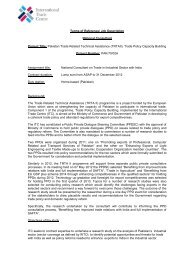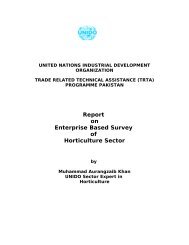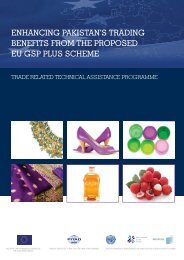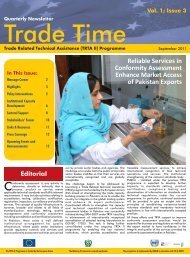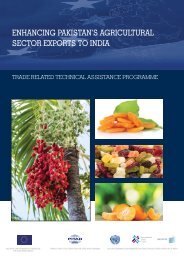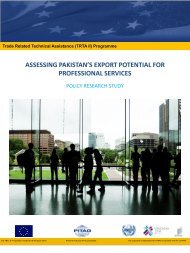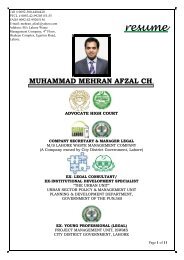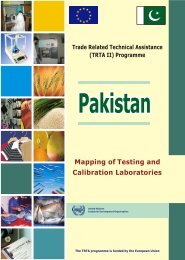Enhancing dairy sector export competitiveness - International Trade ...
Enhancing dairy sector export competitiveness - International Trade ...
Enhancing dairy sector export competitiveness - International Trade ...
Create successful ePaper yourself
Turn your PDF publications into a flip-book with our unique Google optimized e-Paper software.
ENHANCING DAIRY SECTOR EXPORT COMPETITIVENESS IN PAKISTANThe federal government in collaboration with the Food and Agriculture Organization of the United Nations(FAO) has executed a project to progressively control the Foot and Mouth Disease (FMD) in three yeartime (2011-13) in Pakistan. The program is being funded by the United States Agriculture Department.USAID has initiated a project in Khyber Pakhtunkhwa (KPK), Punjab and Sindh that includes sustaining thesurvival of livestock through the provision of feed, fodder and medicine under the Flood RecoveryAgriculture Programs. The Dairy Program also funded by the USAID, to the tune of Rs. 2.5 million for2011-14, aims to increase the productivity of 12,000 small-scale <strong>dairy</strong> farmers by 15-20% through farmmanagement techniques, artificial insemination and promoting linkages with suppliers and higher valuemarkets.The Vision 2030The Vision 2030 explains that the lack of essential development of the <strong>dairy</strong> and livestock <strong>sector</strong> has beendue to poor quality of feed and health coverage, indiscriminate breeding of genetically inferior livestock thatresults in lower productivity, outdated and limited marketing facilities, lack of investment in R&D andmarket infrastructure. On the other hand, the <strong>sector</strong> has remained resilient by showing a sustained growthrate of 4-5 % in the past decade without any major investment. The government’s vision is an efficient andcompetitive sustainable agriculture <strong>sector</strong> ensuring food security and having ability to contribute to theeconomic development for Pakistan.The Livestock and Dairy Development PolicyThe Government of Pakistan launched its first ever Livestock and Dairy Development Policy in 2007 whichformally identified the livestock <strong>sector</strong> as the major source of economic growth and poverty alleviation forthe country. The policy aimed to bring significant positive changes in the livestock and <strong>dairy</strong> <strong>sector</strong>s ofPakistan. Contrary to making livestock as part of the agricultural policy as per previous practice, the <strong>sector</strong>was given significance to provide an independent policy framework to accelerate its development.The policy recognized that the demand for livestock and <strong>dairy</strong> products in Pakistan would rise primarily dueto increase in population over the years and also the rise in income levels. It was also made clear that thisdemand could be met only through increasing the productivity per animal as the number of animals wasalready touching the maximum in terms of land and resources. The policy identified milk as the mainproduct and beef and mutton as the by-products in livestock. It also identified the immense <strong>export</strong> potentialof the livestock and <strong>dairy</strong> <strong>sector</strong>s.Displaying the <strong>competitiveness</strong> of the livestock and <strong>dairy</strong> <strong>sector</strong>s, the policy contained a study in which acomparison of cost of milk production in 31 countries reflected that the Pakistani rural farmers produce milkat just US$ 11 per 100 kg and remained most competitive after Argentina. In fact the country’s rural farmswere found to be more competitive than India, Bangladesh, Western Europe, North America and evenOceania.The policy also identified the constraints faced by the livestock and <strong>dairy</strong> <strong>sector</strong>s including: (i) nonavailabilityof superior germplasm, (ii) inadequate feed resources, (iii) epidemics of infectious diseases, (iv)poor marketing infrastructure, (v) low public <strong>sector</strong> investment, (vi) poor institutional infrastructure, (vii)outdated regulatory framework and (viii) limited availability and access to the farm credit.To balance the above mentioned constraints, the policy provides for a “Private <strong>sector</strong>-led development withthe public <strong>sector</strong> providing the enabling environment and building capacity.” The strategy included thefollowing four elements:i. Private <strong>sector</strong>-led livestock growthii.iii.iv.Productivity enhancement of existing livestock resourcesMoving away from subsistence farming to market-oriented commercial farmingTargeting entire value chain to enhance productivity and profitability52



